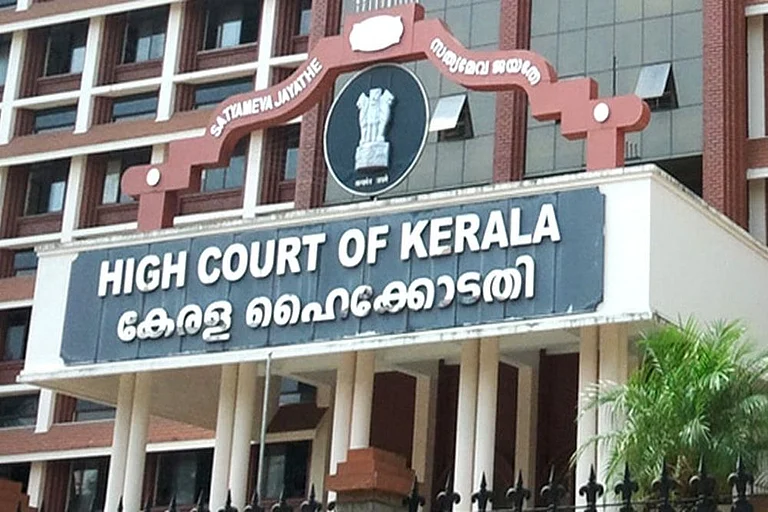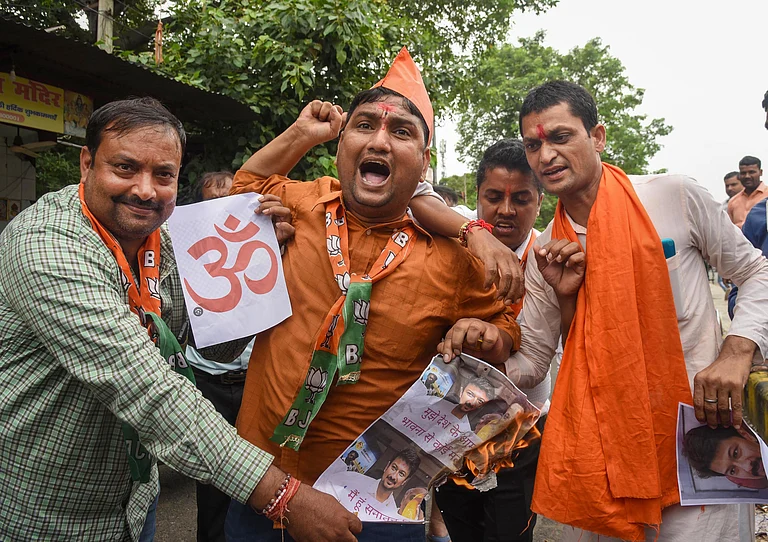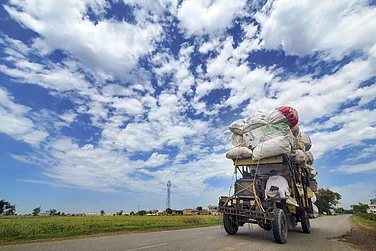The lively Shakthan Thampuran Market, adjacent to the private bus stand in the heart of Thrissur town, has come to life, serving as a prelude to a parliamentary spectacle. The Shakthan market is the most densely-populated locale in Thrissur town where the BJP is mobilising its full might for electoral victory, keeping the actor-turned-politician, Suresh Gopi, in the fray. Thrissur is one of the top five constituencies that the BJP is fighting to win in the next general elections. Amidst the crisscrossing pedestrians, the un-rhythmic hum of buses navigating the stand and the vibrant street vendors, the market is an eventful place, a favourite spot for politicians with electoral aspirations, transforming into a hub of political activity, anticipating the unfolding drama of the elections.
The local BJP leaders claim that, as a Rajya Sabha member, Gopi aimed to modernise the market. However, the corporation led by the Left Democratic Front (LDF) is alleged to have obstructed his efforts. According to Reghunath, one of the BJP conveners in the constituency, “Gopi intended to allocate Rs 1 crore for the market’s modernisation, and he did spend a portion of it, but political adversaries created hindrances.”
However, the market vendors do not acknowledge these claims, but unanimously agree on one point—Gopi has been successful in making inroads in the constituency. Sivakumar, a street vendor and a local leader of the Street Vendors’ Trade Union who operates a small grocery shop in the Shakthan Market, disputes any development initiatives claimed by Gopi in the market, yet he does not belittle his efforts. “I am not aware of any development projects brought by him. We, the street vendors, face a lot of problems. In north India, street vendors are brutally displaced, and their shops are bulldozed. Nothing of that sort happens in Kerala because of the strong presence of trade unions,” he notes. However, he undeniably asserts that the BJP, through Gopi, would pose a tough challenge to the United Democratic Front (UDF) and the LDF in the constituency this time. When asked if Gopi is a good politician, Sivakumar evades the question with a suggestive answer, “He is a good actor.”

Gopi has emerged as ‘Modi’s man’ in Kerala. He is seen as Modi’s choice, a perception that does not sit well with the BJP state leadership. Gopi adopts Modi’s theatrical style, turning every event into a performance—be it his daughter’s wedding, offering ‘blessings’ to youngsters on special occasions, or contributing a ‘golden crown’ to a Catholic Church. (His recent act of offering the crown to Our Lady of Lourdes Metropolitan Cathedral in Thrissur stirred a controversy, widely critiqued as an attempt to attract Christian votes. The crown accidentally fell down as soon as he put it on, and the left-wing social media handles trolled it, linking it to Mother Mary’s reaction to the violence against Christians in Manipur and other states.) In essence, Gopi serves as an indicator of how Kerala responds to Modi’s larger-than-life image.
Modi’s theatrical presentations and assertions on the developmental front resonate with the prosperous middle class.
The recent visits by Prime Minister Narendra Modi to Kerala have purportedly reinvigorated the grassroots machinery of the BJP, assert its leaders. Sampoorna M S in Thrissur, a former correspondent of The Hindu who is now a BJP leader and a national council member, contends that the prime minister’s public meeting in Thrissur on January 3 drew a substantial crowd, with around 2 lakh women in attendance, not exclusively comprising BJP activists. Sampoorna emphasises that women from diverse political affiliations, including the UDF and LDF, displayed enthusiasm to witness the prime minister’s address.
While acknowledging this perspective as emanating from a BJP activist, even individuals aligned with Left-leaning ideologies concede that the ‘Modi impact’ is gaining traction in Kerala. Although the translation of this impact into votes remains a distant prospect, Modi’s theatrical presentations and assertions on the developmental front resonate with the prosperous middle class, a substantial demographic in Kerala that has outperformed other states in terms of the Human Development Index (HDI).
“Since the rise of modern Kerala, the middle class has emerged as a prominent category, compelling even the Left to align with their aspirations without disrupting the feudal, caste-based social order,” asserts Sunil P Ilayidom, a Left intellectual and professor at the Sree Sankaracharya University of Sanskrit, Kalady, Ernakulam district. He observes that the onset of modernity—not only in Kerala, but throughout the nation—did not entail a complete departure from feudalism. Modernity, according to Ilayidom, primarily identified itself with economic logic, yet it did not instigate any substantial shift in the caste-based social hierarchy.
There is a consensus that the surge of saffron politics in Kerala surpasses mere electoral metrics.
Consequently, a leader such as Modi, adept at combining religiosity with developmental narratives, proves successful in captivating the imagination of the middle class. The middle class is fascinated by the religiosity displayed by Modi coupled with his narrative of an India heading to be one of the superpowers in the world.
However, the BJP has to go to great lengths to translate the Modi impact into electoral victory, even in the case of Gopi. The voting history of the state does not provide substantial ground for optimism for the party. The National Democratic Alliance (NDA) achieved its highest performance in Kerala during the 2016 assembly election, securing a 15 per cent vote share. With this vote share, the party achieved its first-ever representation in the legislative assembly, securing victory for O Rajagopal in Nemom constituency of Thiruvananthapuram.
Notably, this success was achieved through an alliance with the BDJS (Bharat Dharma Jana Sena), a political faction within the SNDP (Sree Narayana Dharma Paripalana Yogam), the community organisation of the Ezhava, an affluent OBC caste. The Ezhava community, constituting 23 per cent of the state’s population, is perceived as the strong base of the Left in Kerala. However, this coalition faltered in the subsequent 2021 election—the NDA’s vote share declined to 12.3 per cent, resulting in the loss of its sole seat in the assembly. In 2014, when the country experienced the Modi wave, Kerala did not join the bandwagon, and the BJP was limited to a vote share of 10 per cent. While the BJP retained power under Modi’s charisma in 2019, the party could only gather 13 per cent votes in Kerala.
Irrespective of political allegiances, there is a consensus that the surge of saffron politics in Kerala surpasses mere electoral metrics. “We cannot ignore the deepening cultural influence that saffron politics gains through its multiple organs,” says P N Gopikrishnan, the author of 'The Story of Hindutva Politics'. He contends that the impact of Modi is not only provocative, but also stirs latent communal sentiments among Hindus, particularly those affiliated with the Savarna castes, exacerbating religious divides and harbouring Muslim hate.
Kerala is a state that has had a significant presence of the Rashtriya Swayamsevak Sangh (RSS) since the 1940s. It has been one of the states with the largest number of shakhas. However, the social reformation movements among the backward castes and Dalits and the strong presence of the Communist Party have impeded the growth of Hindutva in Kerala. The profound influence of social reformers such as Sree Narayana Guru, Ayyankali, and Sahodaran Ayyappan (a disciple of Guru) redirected Hindu public life in Kerala, keeping Hindutva at bay. Given the current circumstances, it appears that the ascent of Hindutva might soon undermine the secular fabric of Kerala, which has evolved over centuries.
“The pervasive influence of Hindutva happens at all levels; I can see it at home, the workplace, in my village, and everywhere.” This observation was made by Sumathi, a school teacher in Thalassery, Kannur. Not having undergone formal academic learning on the growth of Hindutva, she observes this cultural shift from her own premises. Sumathi further elaborates, “My 75-year-old mother watches Malayalam television serials, and many of these serials propagate Hindutva culture and beliefs. In these narratives, Hindu gods consistently resolve conflicts, and characters invariably submit themselves to the divine.” Sumathi, an office bearer of the Kerala State Teachers’ Association, an organisation affiliated with the CPI (M), expresses concern over the cultural influence within the televised narratives and its potential impact on societal perceptions.
Ranjith, a teacher at a training school and an active member of the CPI (M) in Thalassery, corroborates this observation. He says, “It is not the BJP directly organising religious and cultural events, but the affiliated saffron groups are actively doing it.” In Kannur, spiritual talks by Hindu leaders have become a routine occurrence. Two months ago, a Somayagam was conducted in a village here, and even people belonging to the CPI (M) participated in the Somayagam, especially women, he says. Ranjith is perplexed as to how to counter the escalating religiosity and Hindutva influence in society.
MORE FROM THIS ISSUE
A closer look at the voting pattern reveals a gradual impact of cultural Hindutva on the electoral landscape in Kerala too. In the 2016 assembly election, marking the historic moment of the BJP securing its first seat in the state, the party engaged in closely contested battles and secured the second position in six constituencies across Kasaragod, Thiruvananthapuram and Palakkad districts. In the 2021 election, amidst the backdrop of the Sabarimala controversy and the ensuing communal sentiments, the BJP secured second position in nine constituencies, with two each in Kasaragod and Palakkad districts and one in Kollam district. Additionally, the party claimed second place in four constituencies in Thiruvananthapuram district. However, it is essential to note that these trends do not necessarily foretell an imminent victory for the BJP in Kerala. The accumulation of votes may enhance the chances of the LDF triumphing, as the floating votes are perceived to erode from the UDF camp.
(This appeared in the print as 'To Win Beyond The Vindhyas')
































